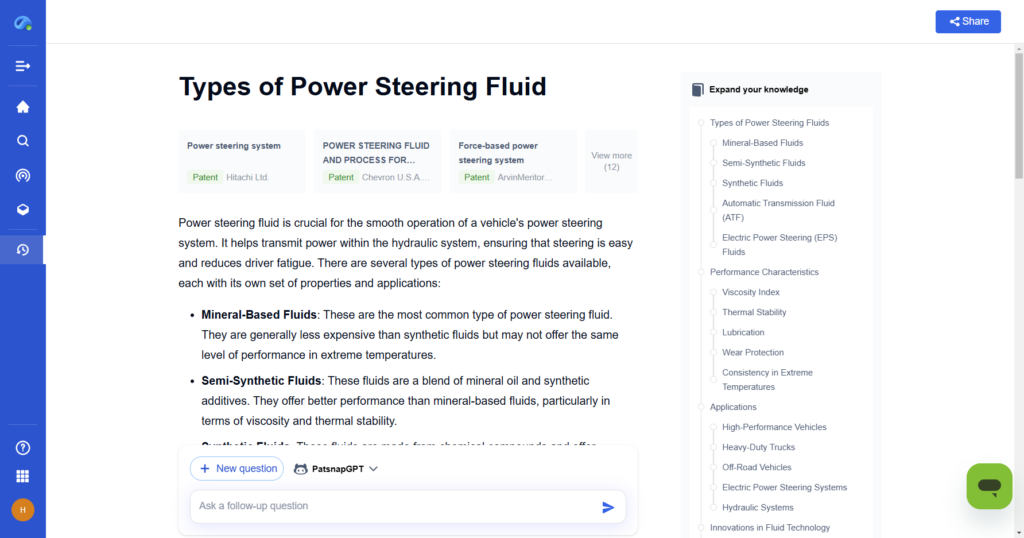
What is Power Steering Fluid?
Power steering fluid is a specialized hydraulic fluid designed for use in automotive power steering systems. Its primary function is to transmit power from the pump to the steering gear, providing the necessary force to assist the driver in turning the vehicle’s wheels. Its composition and properties are carefully engineered to meet the demanding requirements of power steering systems.
What is power steering fluid? Eureka Technical Q&A explains its role in smooth steering, system lubrication, and preventing wear in hydraulic power steering systems.
Composition
Power steering fluids typically consist of a base oil, viscosity index improvers, anti-wear additives, corrosion inhibitors, antioxidants, and other performance-enhancing additives. The base oil can be mineral-based or synthetic, such as polyalphaolefins (PAOs) or esters.
- Base Oil: Provides the primary lubrication and viscosity characteristics. Synthetic base oils like PAOs offer superior low-temperature fluidity and oxidation resistance compared to conventional mineral oils.
- Viscosity Index Improvers: Polymeric additives that help maintain the fluid’s viscosity over a wide temperature range, ensuring proper lubrication at both low and high temperatures.
- Anti-Wear Additives: Compounds like zinc dialkyldithiophosphates (ZDDPs) or esters of phosphonic acids that form protective films on metal surfaces, reducing wear and extending component life.
- Corrosion Inhibitors: Prevent corrosion of metal components by neutralizing acidic byproducts and forming protective layers.
- Antioxidants: Inhibit oxidation and thermal degradation of the fluid, prolonging its service life.
Key Properties
Power steering fluids must possess specific properties to ensure optimal performance and longevity of the power steering system:
- Viscosity and Viscosity Index: Appropriate viscosity at operating temperatures is crucial for efficient power transmission and lubrication. A high viscosity index ensures consistent viscosity over a wide temperature range.
- Thermal and Oxidation Stability: The fluid must resist thermal degradation and oxidation, even at high operating temperatures, to prevent sludge formation and maintain its lubricating properties.
- Anti-Wear and Extreme Pressure (EP) Performance: Effective anti-wear and EP additives protect critical components from wear and seizure under high loads and pressures.
- Low-Temperature Fluidity: Excellent low-temperature pumpability and flow characteristics are essential for smooth operation during cold starts.
- Compatibility: The fluid must be compatible with seals, hoses, and other system components to prevent swelling, shrinking, or degradation.
Types of Power Steering Fluid
What are the types of power steering fluid? Eureka Technical Q&A breaks down conventional, synthetic, and ATF-based fluids, helping you choose the right one for your vehicle.

Hydraulic Power Steering Fluids
- Mineral oil-based fluids: Traditional hydraulic fluids derived from crude oil, suitable for older power steering systems.
- Synthetic hydraulic fluids: Improved performance over mineral oils, including better low-temperature fluidity, oxidation resistance, and lubricity. Examples are polyalphaolefin (PAO) and ester-based fluids.
Electric Power Steering (EPS) Fluids
- Semi-synthetic greases: Formulated with synthetic hydrocarbon oils and thickeners like lithium or calcium soap, providing lubrication for ball screws and gears in EPS systems.
- Fully synthetic greases: Offer superior performance over semi-synthetic greases, with enhanced oxidation stability, low-temperature pumpability, and wear protection for EPS components.
Specialized Power Steering Fluids
- Biodegradable fluids: Environmentally friendly alternatives derived from vegetable oils or synthetic esters, suitable for applications where leakage could contaminate soil or water.
- Fire-resistant fluids: Formulated with phosphate esters or polyol esters, providing fire-resistant properties for high-risk applications like mining or military vehicles.
How to Check Power Steering Fluid?
Checking Power Steering Fluid Level
- Park the vehicle on a level surface and apply the parking brake.
- With the engine running and the steering wheel stationary, check the fluid level in the power steering reservoir. The level should be between the minimum and maximum marks.
- If the level is low, add the recommended fluid until it reaches the proper level.
Inspecting Fluid Condition
- The power steering fluid should be translucent with a reddish or amber color. Dark or discolored fluid indicates contamination or breakdown and needs to be replaced.
- Check for any foaming or aeration in the fluid, which can cause noise and cavitation in the system.
Checking for Leaks
- Inspect all power steering components, including the pump, hoses, and steering gear, for any signs of leaks or seepage.
- Leaks can cause fluid loss, leading to noise, increased steering effort, and potential system failure.
When Should You Change Power Steering Fluid?
Fluid Change Intervals
- Most manufacturers recommend changing power steering fluid every 30,000-60,000 miles or 2-4 years
- However, the fluid condition should be inspected regularly as change intervals can vary based on:
- Driving conditions (heavy load, high temperatures accelerate fluid breakdown)
- Fluid quality and compatibility with system components
- Vehicle age and mileage
Signs for Fluid Change
- Steering becomes harder, especially at low speeds or when stationary
- Whining or groaning noises from the steering pump
- Fluid is dark, discolored, has a burnt smell, or contains contaminants
- Leaks in the power steering system
Importance of Timely Changes
- Prevents accelerated wear of steering components like pump, gear, and hoses
- Maintains proper steering response and feel
- Avoids potential steering failure which is a safety hazard
- Extends service life of the power steering system
In summary, regular changes based on the manufacturer’s recommendations and inspection of fluid condition are crucial for maintaining steering performance, component life, and vehicle safety.
Latest Innovations
Improved Energy Efficiency
Power steering fluids are being formulated with specialized additives to increase the energy efficiency of the transmission during operation, leading to improved fuel economy. These additives enhance power transmission properties by reducing friction and wear. For instance, imidazolines, succinimides, and tertiary amines are used as friction modifiers to optimize the fluid’s friction characteristics.
Enhanced Oxidation and Shear Stability
Oxidation and shear stability are crucial for power steering fluids due to the high temperatures and pressures they encounter. Anti-oxidants like alkyl diphenylamines and liquid phenolic compounds are added to improve oxidation resistance. Polymethacrylates and pentaerythritol tetra oleates are used to enhance shear stability, ensuring the fluid maintains its viscosity over extended periods.
Electro-Hydraulic and Electric Power Steering Systems
Conventional hydraulic power steering systems are being replaced by more efficient electro-hydraulic and electric power steering systems. Electro-hydraulic systems use an electric motor to drive the hydraulic pump on-demand, reducing parasitic losses. Electric power steering systems eliminate the need for hydraulic fluid altogether, relying solely on electric motors to provide steering assistance.
Adaptive and Intelligent Control
Advanced control strategies are being implemented to optimize power steering performance and efficiency. Adaptive systems can vary the pump speed or pressure based on steering wheel torque and vehicle speed, reducing energy consumption when minimal assistance is required. Intelligent control algorithms use sensor data and predictive models to anticipate steering demands, enabling faster response times and improved steering feel.
Environmentally Friendly Formulations
There is a growing focus on developing power steering fluids with improved environmental performance. Low-VOC and solvent-free formulations are being introduced to reduce emissions. Additionally, biodegradable and renewable base oils, such as esters and polyalphaolefins, are being explored as alternatives to conventional mineral oils.
Application Case
| Product/Project | Technical Outcomes | Application Scenarios |
|---|---|---|
| Bosch Servoline Power Steering Fluid | Utilising advanced synthetic base oils and specialised additives, Bosch Servoline offers superior low-temperature fluidity, oxidation resistance, and anti-wear protection, extending the service life of power steering systems. | Suitable for modern power steering systems in passenger vehicles, ensuring smooth and responsive steering performance across a wide temperature range. |
| Mobil 1 Synthetic Power Steering Fluid | Formulated with high-quality synthetic base oils and advanced additives, Mobil 1 Synthetic Power Steering Fluid delivers exceptional thermal stability, low-temperature performance, and wear protection, reducing system noise and extending component life. | Recommended for use in a wide range of power steering systems, particularly in high-performance vehicles and extreme operating conditions. |
| Pentosin CHF 11S Power Steering Fluid | Incorporating advanced synthetic esters and specialised friction modifiers, Pentosin CHF 11S offers exceptional lubrication properties, minimising pump noise and vibration while providing superior wear protection for critical components. | Designed for use in modern power steering systems, particularly those found in European vehicles, ensuring smooth and precise steering response. |
| Prestone Power Steering Fluid with Conditioners | Formulated with advanced conditioners and anti-wear additives, Prestone Power Steering Fluid helps maintain system cleanliness, prevents sludge and varnish buildup, and provides superior protection against wear and corrosion. | Suitable for use in a wide range of power steering systems, particularly in older vehicles or those operating in harsh environments. |
| Valvoline Synthetic Power Steering Fluid | Utilising high-quality synthetic base oils and advanced additives, Valvoline Synthetic Power Steering Fluid offers exceptional thermal stability, low-temperature performance, and wear protection, ensuring smooth and responsive steering operation. | Recommended for use in modern power steering systems, particularly in vehicles operating in extreme temperatures or severe driving conditions. |
Technical challenges
| Improving Energy Efficiency of Power Steering Fluid | Formulating power steering fluids with specialised additives to enhance energy efficiency and reduce friction during operation, leading to improved fuel economy. |
| Enhancing Oxidation and Shear Stability of Power Steering Fluid | Incorporating anti-oxidants and shear stability improvers in power steering fluid formulations to improve oxidation resistance and maintain viscosity over extended periods under high temperatures and pressures. |
| Transitioning to Electro-Hydraulic and Electric Power Steering Systems | Replacing conventional hydraulic power steering systems with more efficient electro-hydraulic and electric power steering systems to reduce parasitic losses and improve fuel efficiency. |
| Optimising Friction Characteristics of Power Steering Fluid | Utilising friction modifiers like imidazolines, succinimides, and tertiary amines in power steering fluid formulations to optimise friction properties for enhanced performance. |
| Extending Service Life of Power Steering Fluid | Developing power steering fluid formulations with improved anti-shear and anti-oxidation properties to extend the service life and reduce maintenance intervals. |
To get detailed scientific explanations of power steering fluid, try Patsnap Eureka.


